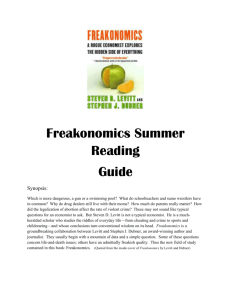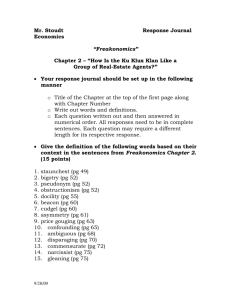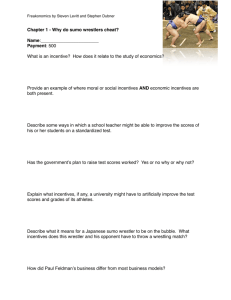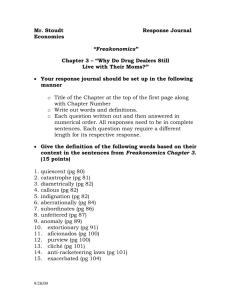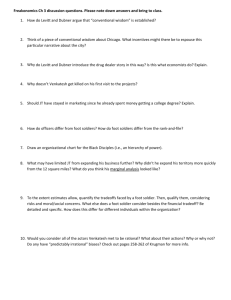File
advertisement
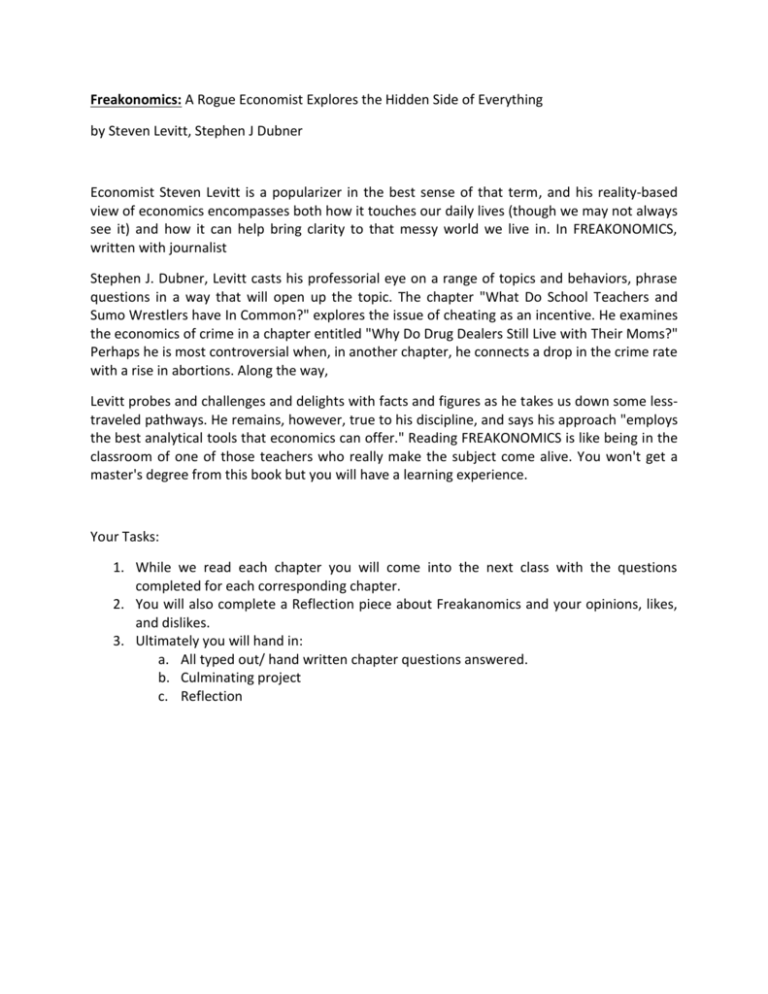
Freakonomics: A Rogue Economist Explores the Hidden Side of Everything by Steven Levitt, Stephen J Dubner Economist Steven Levitt is a popularizer in the best sense of that term, and his reality-based view of economics encompasses both how it touches our daily lives (though we may not always see it) and how it can help bring clarity to that messy world we live in. In FREAKONOMICS, written with journalist Stephen J. Dubner, Levitt casts his professorial eye on a range of topics and behaviors, phrase questions in a way that will open up the topic. The chapter "What Do School Teachers and Sumo Wrestlers have In Common?" explores the issue of cheating as an incentive. He examines the economics of crime in a chapter entitled "Why Do Drug Dealers Still Live with Their Moms?" Perhaps he is most controversial when, in another chapter, he connects a drop in the crime rate with a rise in abortions. Along the way, Levitt probes and challenges and delights with facts and figures as he takes us down some lesstraveled pathways. He remains, however, true to his discipline, and says his approach "employs the best analytical tools that economics can offer." Reading FREAKONOMICS is like being in the classroom of one of those teachers who really make the subject come alive. You won't get a master's degree from this book but you will have a learning experience. Your Tasks: 1. While we read each chapter you will come into the next class with the questions completed for each corresponding chapter. 2. You will also complete a Reflection piece about Freakanomics and your opinions, likes, and dislikes. 3. Ultimately you will hand in: a. All typed out/ hand written chapter questions answered. b. Culminating project c. Reflection Chapter 1 - Why do school teachers and sumo wrestlers cheat? 1. What is an incentive? How does it relate to the study of economics? 2. Provide an example of where moral or social incentives AND economic incentives are both present. 3. Describe some ways in which a school teacher might be able to improve the scores of his or her students on a standardized test. 4. Has the government’s plan to raise test scores worked? Yes or no why or why not? 5. Explain what incentives, if any, a university might have to artificially improve the test scores and grades of its athletes. 6. Describe what it means for a Japanese sumo wrestler to be on the bubble. What incentives does this wrestler and his opponent have to throw a wrestling match? 7. How did Paul Feldman’s business differ from most business models? 8. What do the authors of Freakonomics conclude from an analysis of the Paul Feldman’s bagel sales data? Do these conclusions match with economists’ expectations of human behavior? 9. Based on what can be learned from a study of sales data of the bagel business, what variables affect the incidence of theft in an office setting? Chapter 2 - How is the KKK like a group of real estate agents? 1. Consider how the Ku Klux Klan came into existence and how its level of popularity varied over time. Identify specific factors that caused the Klan’s popularity to rise or fall. 2. Explain Stetson Kennedy’s role in the Klan’s ultimate decline in popularity in the South, focusing on the role the dissemination of what the Klan believed was secret information played in that process. 3. Explain what is meant by the term “information asymmetries” and give examples of information asymmetries we encounter in everyday life. 4. Explain whether, and if so, how, information asymmetries create a competitive advantage for particular individuals. Explain how such innovations as the Internet have affected the prevalence of information asymmetries. 5. Explain how information asymmetries facilitated the corporate scandals that occurred in the early 2000s. 6. Explain how the introduction of the element of fear makes the problem of the information asymmetry even worse. 7. What evidence do the authors offer to support their claim that real estate agents exploit an information asymmetry to their client’s detriment? 8. As more clients become aware of the possibility of such behavior by agents, how might it affect the relationship between the two? 9. Explain how the choice of terms a real estate agent uses to describe a particular property conveys additional information about the property, and hence the price a potential buyer might be able to successfully offer the seller. 10. This chapter examines how the economic incentives of a real estate agent may differ from those of his or her client. What other subject matter experts are often hired by individuals and businesses? Might they have incentives that differ from those of the clients that hire them? 11. Assuming many of the people who use Internet dating sites are not being truthful when they describe themselves, what could motivate them to do so, knowing that if they ever actually met a date face-to-face, the truth would likely come out? Chapter 3 - Why do drug dealers live with their moms? 1. What is “conventional wisdom?” What are some ways that “conventional wisdom” comes into being? 2. Explain why challenging the “conventional wisdom” with regard to a sticky social issue may be difficult to do. 3. Considering this chapter’s analysis of the transformation of Listerine from an antiseptic to a cure for halitosis, what can one conclude about the effect of advertising on market demand for a good or service? 4. Explain how the incentives of police departments and the public media gave rise to explanations of the rising crime rate in the 1980s that were totally wrong. 5. Describe, in general terms, the organizational structure of the Black Disciples street gang. How is it similar to the organizational structure of most business? 6. Explain how four years of financial records of the Black Disciples street gang found their way into the hands of a University of Chicago graduate student. 7. How did J.T., a branch leader of a Black Disciples street gang, acquire and maintain a regional monopoly over crack cocaine within the territorial domain of the gang? 8. Explain how a “tournament” or “winner take all” labor market works. Why would a street-level drug dealer be willing to accept low pay and poor working conditions? Give your own examples of a “tournament” type of labor market. 9. How do the incentives of the street-level drug salesman differ from those of the gang leader/franchise owner? Are they both attempting to maximize the profits of the gang? Why or why not? 10. How did the invention of crack cocaine transform the urban street gang? Chapter 4 - Where have all the criminals gone? 1. In economic terms, what was Nicolae Ceausescu’s rationale for banning abortion in Romania, i.e., how did he see banning abortion befitting the Romanian economy? 2. Describe the incentives Ceausescu used to increase the birth rate in Romania. Were these incentives effective? Explain. 3. As a result of Ceausescu’s policies, what happened to the average quality of life in Romania? Provide an economic explanation for the change that occurred. 4. Describe the general behavior of the crime rate in the United States between 1970 and 1999, i.e., indicate whether it was increasing or decreasing from year to year. 5. List each of the explanations of the drop in the crime that occurred in the 1990s that are evaluated by Levitt and Dubner. 6. What rationale do some criminologists offer for the argument that imprisonment rates should be lowered as part of the effort to reduce crime in the United States? Was their logic sound? If not, what fallacy did they commit? 7. What does the available evidence have to say about whether increased reliance on capital punishment as a viable explanation for the drop in crime in the 1990s? 8. Many observers maintained that the drop in crime in the 1990s was at least in part due to the adoption of innovative policing strategies. Focusing on the experience in New York City, what do the data tell us about the viability of this assertion? Should we then conclude that smart policing is not a good thing? Why or why not? 9. Did the “graying of America” help bring down the crime rate in the 1990s? Why or why not? 10. Summarize the argument by Donahue and Levitt regarding the relationship between the drop in crime in the 1990s and the legalization of abortion as a result of Roe v. Wade. Your summary should focus on such factors as the characteristics of the average criminal (e.g., average age, home life), what happened in states that legalized abortion prior to the decision in Roe v. Wade, and the type of woman who is likely to take advantage of Roe v. Wade. Chapter 5 - What makes a perfect parent? 1. How does the information in this chapter regarding the contradictory and confusing assemblage of information from parenting experts support the major theme of this book (Hint: incentives matter)? 2. Based on the example of perfect parenting in this chapter, provide examples that illustrate how the combination of asymmetric information and fear can lead to inefficient outcomes. 3. When looking at statistical data over a period of time, what does “correlation” mean? How is it different from “causation?” 4. According to the data in this chapter, what are the main differences between a school which overwhelmingly has black students versus a school which overwhelmingly has white students? 5. Academically, how well does an average black student do in a “bad” school? How is this different from an average white student in a “bad” school? 6. According to the data developed from the ECLS, what is more important regarding a child’s success on standardized tests: what a parent does for a child or what a parent is? In your opinion, what might be an explanation for such a strange conclusion? 7. According to the data developed from the ECLS, having lots of books in the home is correlated with higher scores on a child’s tests, reading to the child nearly every day is not. If a parent were only interested in having his or her child achieve higher scores on standardize tests, what would you imagine his or her benefit/cost considerations to be when it came to the purchase of books and this use of his or her time? Chapter 6 - Perfect Parenting Part II 1. What do the experiences of Winner Lane, Loser Lane, and Temptress tell us about the likely relationship between a child’s name and his/her prospects for success in life? Are these examples sufficient for us to draw any definitive conclusions? Why or why not? 2. Why is the California birth certificate data set so valuable from the economist’s perspective? In particular, what type of data does it include that would be of interest to economists? Why are the variables you listed so useful/valuable? 3. What do the California names data tell us about the similarity between the names black parents and white parents gave their children up until the early 1970s and in the period of time since then? 4. Summarize the degree of uniqueness of names given to black girls and black boys revealed in the California names data. What do the authors cite as the most likely cause of this phenomenon? 5. Summarize the characteristics of a black parent who is most likely to give his/her child a distinctively black name. 6. Are the results of audit studies regarding the effects of a person’s name on that Person’s prospects for success reliable? If not, why not? 7. According to the analysis of the California names data, does a person with a distinctively black name have, on average, a worse life outcome than a person with a distinctively white name? If so, is it the fault of the name? If not, explain what the data are telling us. 8. Is there a discernible pattern in how certain names move through the population over time? If so,describe it. 9. Is a low-income parent more likely to choose the name of a celebrity or the child of an upper-income family for his/her own child. Why? 10. According to the California names data, what are many parents trying to signal when they choose a particular name for their child? 1 2 3 4
